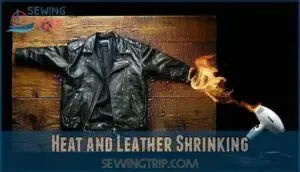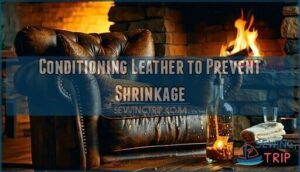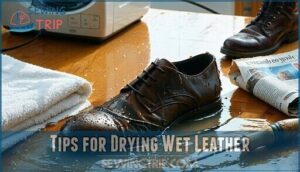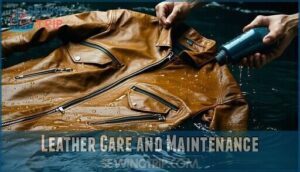This site is supported by our readers. We may earn a commission, at no cost to you, if you purchase through links.
 Yes, leather does shrink when wet, but it’s the drying process that causes the real damage.
Yes, leather does shrink when wet, but it’s the drying process that causes the real damage.
When water penetrates leather fibers, they become temporarily pliable, but as moisture evaporates, those fibers contract and tighten like a rubber band snapping back.
This creates shrinkage, stiffness, and potential cracking.
Vegetable-tanned leather shrinks more than chrome-tanned varieties.
Heat accelerates this process dramatically—never use hair dryers or direct sunlight on wet leather.
Instead, air-dry slowly at room temperature and condition afterward.
The key isn’t avoiding water entirely but managing how your leather dries when it inevitably gets soaked.
Table Of Contents
Key Takeaways
- Your leather will shrink during drying, not when it gets wet – the real damage happens as moisture evaporates and fibers contract, potentially reducing size by up to one full size
- Heat accelerates shrinkage dramatically – you’ll cause permanent damage if you use hair dryers, direct sunlight, or heating vents on wet leather, so always air-dry at room temperature
- Different leather types shrink differently – you’ll see more shrinkage in vegetable-tanned, corrected grain, and split leathers compared to full-grain varieties that resist moisture damage better
- Prevention beats repair every time – you can’t fully reverse shrinkage once it happens, so focus on waterproofing treatments, regular conditioning, and proper storage to protect your investment
Leather Shrinking Basics
You’ve probably wondered if your leather jacket will shrink after getting caught in the rain, and the answer isn’t as straightforward as you might think.
Understanding what happens when leather meets water requires knowing how different types of leather react to moisture and what factors contribute to shrinkage.
What Causes Leather to Shrink
Behind every leather shrinkage problem lies a simple truth: your leather’s collagen fibers contract when moisture escapes and temperatures rise.
Moisture damage weakens these leather fibers, causing them to tighten during drying. Heat accelerates this fiber contraction, while your leather type determines shrinkage severity.
Understanding these shrinkage factors helps you prevent costly leather water damage before it ruins your favorite items.
Regular use of leather moisture meters can help monitor and control the moisture levels in your leather goods, and is a key part of leather care.
Types of Leather Prone to Shrinking
Not all leather types handle water the same way. Understanding which ones shrink most helps you make smarter choices and avoid costly mistakes.
Here are the three most shrinkage-prone leather types:
- Suede Leather – The porous surface absorbs water quickly, leading to stiffening and permanent texture loss
- Corrected Leather – Artificial grain processing weakens fibers, making them susceptible to moisture damage and distortion
- Split Leather – Lower-grade material lacks the protective top grain, allowing water penetration and significant shrinkage
Full Grain leather resists shrinking best due to its dense structure, while Aniline Leather requires careful handling despite its premium quality.
To maintain the quality of suede leather products, this is key to understanding suede leather care techniques.
Effects of Moisture on Leather
When moisture penetrates leather, it sets off a chain reaction that compromises the material’s integrity.
Water causes leather fibers to swell initially, but as moisture levels drop during drying, fiber contraction occurs, leading to shrinkage and potential leather damage.
This process strips natural oils, reducing water resistance and creating conditions for leather water stains and leather moisture damage, making proper leather shrink prevention and gentle leather drying methods essential.
The leather stretching process involves understanding how leather stretch methods affect its overall durability and water resistance.
Does Leather Shrink When Wet
Yes, water causes leather to shrink through a straightforward process.
When wet, leather fibers absorb moisture and swell initially, but here’s where the trouble starts: as the leather dries, those same fibers contract and tighten.
This creates measurable shrinkage that can reduce your leather item by up to one full size if you’re not careful.
The shrinking happens because water strips away natural oils and tannins that keep leather material flexible.
Without these protective elements, the drying process becomes harsh on the leather finish.
Different leather types respond differently – corrected grain and split leathers shrink more than full-grain varieties.
Water damage doesn’t just mean shrinkage.
You’ll also notice leather water stains, color changes, and increased brittleness.
The leather restoration process becomes necessary when moisture damage occurs repeatedly.
Proper wet leather care focuses on gentle drying methods rather than rushing the process, which prevents severe leather moisture damage and maintains your item’s original size and flexibility.
Understanding the leather stretch methods is essential to handling wet leather and minimizing damage.
Heat and Leather Shrinking
While moisture alone causes leather to shrink, adding heat accelerates the process and makes the damage much worse.
You’ll see the most dramatic shrinkage when wet leather gets exposed to high temperatures from hair dryers, direct sunlight, or heating vents, which can cause significant damage due to the combination of moisture and heat.
How Heat Affects Leather Fibers
Heat transforms leather at the molecular level, breaking down collagen’s triple-helix structure once temperatures exceed critical thresholds.
Heat breaks down leather’s molecular structure, causing permanent fiber damage beyond repair.
Chrome-tanned leather resists thermal stress up to 100°C, while vegetable-tanned varieties succumb at 70°C.
This fiber contraction becomes irreversible, causing permanent shrinkage and brittleness that no amount of leather conditioning can fully restore.
Understanding suede shrinkage causes is essential for maintaining the quality of leather and suede materials.
Sun Exposure and Leather Shrinkage
Direct sunlight’s powerful rays can wreak havoc on your leather goods through UV damage and intense heat.
Solar impact causes leather fading while accelerating water evaporation, creating rapid shrinkage that’s often irreversible.
Heat resistance varies by leather type, but consistent sun protection prevents both discoloration and structural damage.
Regular leather conditioning maintains flexibility against harsh environmental conditions.
Using Heat to Dry Wet Leather
When your leather gets soaked, resist the urge to speed things up with heat.
Heat isn’t your friend when leather gets wet—patience prevents permanent shrinkage.
Hairdryers, radiators, and direct sunlight create heat damage by forcing leather fibers to contract rapidly.
This aggressive drying method causes irreversible shrinkage and brittleness.
Instead, stick to room temperature air drying for proper shrinkage control and leather protection.
Preventing Leather Shrinking
Now that you understand the potential damage water can cause to leather, you’ll want to focus on prevention rather than repair.
The good news is that protecting your leather items from shrinkage doesn’t require expensive products or complicated techniques—just consistent care and the right approach when accidents happen, which is all about consistent care.
Methods to Prevent Water Damage
Protecting your leather from water damage starts with prevention. Smart strategies keep your investment looking new for years to come.
- Water Repellents: Apply leather water repellent sprays or creams regularly to create a protective barrier against moisture
- Leather Coatings: Use specialized leather waterproofing treatments that penetrate fibers while maintaining breathability
- Moisture Control: Store leather items in dry environments with proper ventilation to prevent humidity buildup
Quality leather protection products form an invisible shield without compromising the material’s natural flexibility. These leather treatment options work by filling pores and creating water resistance while preserving the leather’s authentic appearance and feel.
Effective leather care involves using a leather water repellent system to maintain the material’s integrity.
Conditioning Leather to Prevent Shrinkage
Regular conditioning creates your best defense against shrinkage.
Leather conditioners with natural oils replenish moisture, keeping fibers flexible and resilient.
Apply leather protectors monthly, focusing on high-wear areas where water damage starts first.
Using the right leather conditioners is essential for maintaining leather health.
| Product Type | Primary Benefit | Application Frequency |
|---|---|---|
| Leather Conditioners | Moisture retention and fiber flexibility | Every 2-3 months |
| Leather Wax | Water resistance and surface protection | Every 4-6 months |
| Leather Sealers | Long-term waterproofing barrier | Annually or bi-annually |
Leather treatment options range from lightweight oils for daily-use items to heavy-duty leather water repellent for outdoor gear.
Test any leather waterproofing product on hidden areas first.
Proper leather humidity control through conditioning prevents the fiber contraction that causes permanent shrinkage when leather gets wet.
Tips for Drying Wet Leather
When your leather gets soaked, patience becomes your best friend.
Remove excess moisture using clean, absorbent towels—never wring or twist the material.
Air dry at room temperature away from direct heat sources like radiators or hair dryers.
Stuff shoes with newspaper to maintain shape during drying.
Proper drying methods prevent shrinking leather and preserve water resistance through controlled humidity.
Using a leather dryer tool can also help speed up the drying process.
Leather Care and Maintenance
Once you’ve protected your leather from water damage, you’ll need proper care to keep it looking great for years.
The right maintenance routine can restore shrunk leather and prevent future problems, which is a complete concept to consider for long-term leather health.
How to Restore Shrunk Leather
When shrinkage happens despite your best efforts, restoration becomes your lifeline.
Start by gently cleaning away dirt and debris, then focus on rehydrating the fibers. Here’s your restoration roadmap:
- Clean carefully – Use mild leather cleaning tips to remove surface grime without adding moisture
- Rehydrate slowly – Apply leather oil or conditioning products to soften stiff fibers gradually
- Stretch gently – Work the leather with your hands while damp to encourage flexibility
- Condition thoroughly – Finish with quality leather conditioning to prevent future shrinking leather issues
Understanding suede shrinkage causes is essential for effective restoration.
Professional leather repair services can handle severe cases where DIY restoration tips fall short.
Best Practices for Leather Storage
When storing leather items long-term, you’re basically protecting an investment that can last decades with proper care.
Humidity control remains your strongest defense against leather water exposure and subsequent fabric shrinkage.
Store leather goods in breathable cotton bags rather than plastic, which traps moisture and promotes mold growth.
| Storage Factor | Recommended Range | Why It Matters |
|---|---|---|
| Humidity | 45-55% | Prevents cracking and mold growth |
| Temperature | 60-70°F | Maintains leather flexibility |
| Light Exposure | Minimal UV | Prevents fading and drying |
| Air Circulation | Moderate flow | Reduces moisture buildup |
| Storage Materials | Cotton/canvas bags | Allows leather to breathe naturally |
Climate regulation prevents the expansion-contraction cycle that weakens leather fibers over time.
Apply leather conditioning products before storage, creating a protective barrier that maintains water resistance.
Avoid attics, basements, or areas with temperature fluctuations that compromise your leather cleaning tips routine’s effectiveness.
Proper storage maintains leather flexibility and prevents mold growth, ensuring your items remain in good condition.
By following these guidelines, you can ensure the longevity of your leather goods and protect your investment.
Regular Maintenance for Long-Lasting Leather
Consistency is your leather’s best friend in terms of longevity.
Schedule leather cleaning every 6-12 months and leather conditioning every 3-6 months to maintain suppleness.
Use quality leather care products designed for your specific leather type.
Regular leather protection with UV-resistant sprays shields against leather water exposure and prevents leather fabric shrinkage.
This routine approach to leather preservation guarantees your items resist water resistant leather deterioration while maintaining their original appearance and structure.
Frequently Asked Questions (FAQs)
Does leather get tighter when wet?
When you get leather wet, it’ll initially feel looser and more pliable.
But here’s the catch—as it dries, those fibers contract and tighten up substantially, making your leather item feel tighter than before.
What will happen to leather if it gets wet?
Wet leather can shrink up to one full size when dried improperly.
When you get leather wet, it’ll contract as fibers tighten, lose natural oils, become brittle, and may develop color changes or stains during the drying process.
Does leather shrink after washing?
Yes, leather shrinks after washing because water causes fibers to contract during drying. You’ll see the most shrinkage if you use heat while drying, potentially losing a full size.
Does leather stretch and shrink?
Leather both stretches and shrinks depending on conditions you expose it to.
When wet, leather fibers contract during drying, causing shrinkage, while consistent stretching forces can permanently elongate it over time.
Can leather shrink multiple times after repeated wetting?
If you keep soaking and drying leather, it’ll shrink more each time—like jeans that get tighter with every wash.
Each cycle pulls fibers closer, stealing flexibility and making your leather stiffer and smaller over time.
Does shrinking affect leathers color or appearance permanently?
Shrinkage doesn’t just change leather’s size—it permanently alters its appearance too.
You’ll notice color shifts, blotching, and uneven tones as water strips natural oils and tannins, leaving lasting visual damage that won’t reverse, causing permanent alterations.
Which leather products shrink most when exposed to water?
Like Achilles’ heel, thin and processed leathers suffer most.
You’ll find corrected grain and split leathers shrink substantially more than full-grain types when wet, with suede and bonded leather being particularly vulnerable.
How long does wet leather take to shrink completely?
You’ll notice shrinkage beginning within hours as wet leather starts drying, but complete shrinkage takes 24-48 hours depending on thickness, temperature, and humidity levels around your leather item.
Conclusion
Water acts as leather’s double-edged sword—it softens then betrays.
Understanding whether leather shrinks when wet empowers you to protect your valuable items. Yes, leather does shrink when wet during the drying phase, but proper care prevents permanent damage.
Air-dry slowly, avoid heat sources, and condition afterward to maintain flexibility. With knowledge and patience, you’ll keep your leather goods looking their best for years.
- https://www.vintageleather.store/blogs/vintage-leather-sydney/way-to-shrink-leather
- https://www.thefedoralounge.com/threads/any-experiences-with-soaking-and-drying-leather-to-slightly-alter-the-size.107320/
- https://www.leatherneo.com/blogs/news-and-stories/how-to-handle-wet-leather
- https://www.reddit.com/r/Leathercraft/comments/l6a8r0/any_suggestions_on_keeping_wet_formed_leather/
- https://buffalojackson.com/blogs/insight/can-leather-get-wet











